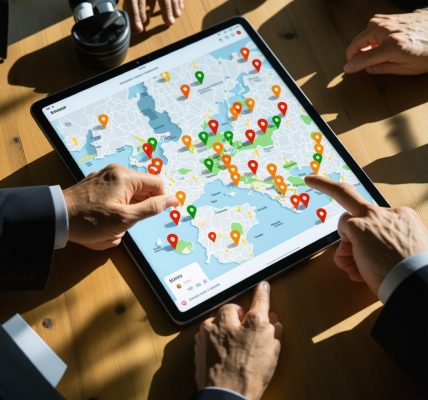Unlocking the Power of SEO-Optimized GMB Descriptions for Local Visibility
In the competitive landscape of local search, crafting Google My Business (GMB) descriptions that seamlessly integrate SEO keywords is no longer a mere best practice but an essential component of a robust local SEO strategy. As an SEO expert, understanding the nuanced interplay between keyword placement, user intent, and semantic relevance can dramatically elevate your Google Business Profile (GBP) rankings and attract targeted local traffic.
Deciphering the Intricacies of Semantic SEO in GMB Content
Semantic SEO transcends simple keyword stuffing; it involves creating content that resonates with the searcher’s intent while maintaining contextual relevance. When optimizing GMB descriptions, consider incorporating LSIs (Latent Semantic Indexing) keywords naturally. For example, alongside primary keywords like “best Italian restaurant,” include related terms such as “family-friendly dining,” “authentic pasta,” and “local Italian cuisine” to enhance topical authority and search relevance.
Strategic Placement of Keywords for Maximum Impact
Expert-level optimization entails strategic keyword placement within the description. Prioritize placing primary keywords at the beginning to signal relevance to both Google and users. Additionally, use variations and long-tail keywords within the description, aligning with user search queries. Remember, a well-crafted, keyword-rich description should read organically, providing genuine value and clarity to potential customers.
How to Balance Keyword Optimization with User Engagement
Over-optimization can lead to diminished user experience and potential penalties. To avoid this, intersperse keywords within compelling narratives about your business. Highlight unique selling propositions, special services, or local community involvement. This approach fosters trust and encourages engagement, which are critical signals for local search algorithms.
What are the most effective ways to measure the impact of keyword optimization in GMB descriptions?
Measuring the impact involves tracking key metrics such as local search rankings, click-through rates, and customer inquiries directly attributed to Google My Business insights. Tools like local SEO analytics provide comprehensive reports on visibility and engagement, allowing for iterative refinement of description strategies.
Continuous Optimization: Keeping Descriptions Fresh and Relevant
Regular updates to GMB descriptions, aligned with evolving keyword trends and seasonal offers, sustain search relevance. Implementing a routine audit—using tools like GMB SEO audits—ensures descriptions remain optimized and competitive.
For further mastery, explore comprehensive Google Business SEO guides and contribute your insights to community forums to refine your approach continually.
Leveraging User Intent for Hyper-Targeted GMB Descriptions
Understanding and aligning your GMB descriptions with specific user intent is a sophisticated approach that can significantly enhance local search visibility. Instead of generic keywords, analyze common queries your target audience uses—such as “affordable Italian restaurants near me” or “best pizza delivery in downtown”—and craft descriptions that directly address these needs. Incorporating detailed, intent-driven content not only improves relevance but also positions your profile as the best solution to local search queries.
Integrating Structured Data for Enhanced Local SEO
One often overlooked facet of optimizing GMB descriptions involves the strategic use of structured data markup. While Google primarily pulls information from your profile content, embedding schema.org markup on your website can reinforce the information provided in your GMB profile, creating a cohesive local SEO ecosystem. For instance, marking up your business hours, services, and reviews helps Google better understand your offerings, leading to improved rankings and rich snippets in local results. To implement this, consult authoritative resources like Google’s structured data guidelines.
Can AI and Natural Language Processing Revolutionize GMB Content Optimization?
Emerging AI tools leveraging Natural Language Processing (NLP) are transforming how local businesses craft and refine their GMB descriptions. These tools can analyze competitor profiles, identify keyword gaps, and generate contextually relevant content faster than traditional methods. By harnessing AI-driven insights, local businesses can craft descriptions that resonate more authentically with user queries, improving both engagement and rankings. For example, platforms like Google Maps SEO strategies for 2025 highlight the importance of integrating AI to stay ahead in local search.
Are you utilizing AI tools to refine your GMB descriptions and capitalize on local search trends? Sharing your experiences or questions can help foster a community of growth and innovation around local SEO strategies.
What innovative techniques can local businesses adopt today to future-proof their GMB descriptions against evolving search algorithms?
Staying ahead of the curve requires continuous learning and adaptation. Regularly updating descriptions with seasonal keywords, leveraging user-generated content, and integrating multimedia elements like images and videos can make your profile more engaging and search-friendly. Furthermore, monitoring local search trends through tools like BrightLocal or Moz Local can help you anticipate shifts in user behavior and search algorithms, allowing you to proactively adjust your descriptions for sustained visibility. For more in-depth tactics, visit Understanding Local SEO for Small Businesses.
Harnessing the Power of Semantic Context for Hyper-Targeted GMB Content
Beyond keyword stuffing, leveraging semantic context entails crafting descriptions that mirror the nuanced language and intent of your target audience. This involves integrating LSIs (Latent Semantic Indexing) keywords and related phrases naturally within your content. For instance, a bakery might include terms like “artisan bread,” “gluten-free options,” and “local pastry shop” to establish topical authority and improve relevance in local searches. Using semantic-rich language not only enhances search visibility but also creates a more engaging narrative that resonates with potential customers, fostering trust and encouraging action.
Strategic Placement and Variations of Keywords for Maximum Local Impact
Expert-level optimization requires meticulous placement of primary and secondary keywords. Position core keywords at the beginning of your descriptions to immediately signal relevance. Additionally, employ long-tail variations aligned with common search queries, such as “affordable Italian restaurants near me” or “best pizza delivery downtown.” This approach caters to diverse user intents and search behaviors, increasing your chances of appearing in a broader array of local searches. Remember, the goal is to maintain a natural, compelling flow—keyword integration should never hinder readability or user engagement.
Measuring and Analyzing the Effectiveness of Your GMB Keyword Strategies
Quantifying the success of your optimization efforts involves tracking metrics such as local search rankings, click-through rates, and customer engagement through tools like BrightLocal or Moz Local. These analytics provide valuable insights into how your descriptions influence visibility and user behavior. For example, a spike in profile views or inquiries after updating your description indicates improved relevance. Regularly reviewing these metrics allows you to refine your keyword strategy, ensuring your GMB profile remains competitive amidst evolving local search algorithms.
How do emerging NLP technologies revolutionize the way businesses craft and refine GMB descriptions?
NLP-driven AI tools can analyze vast amounts of competitor data, identify keyword gaps, and generate contextually relevant content faster and more accurately than manual methods. These tools can simulate human-like language patterns, ensuring descriptions are both optimized for algorithms and appealing to users. For instance, platforms like Google Maps SEO strategies for 2025 highlight how integrating AI can maintain a competitive edge in local search. By adopting NLP technologies, businesses can stay ahead of algorithm updates and enhance their profile effectiveness.
Are you leveraging these advanced tools? Sharing your experiences can help build a community of innovative local SEO practitioners ready to adapt to future search landscape shifts.
What innovative techniques can local businesses implement today to future-proof their GMB descriptions against algorithm evolution?
To stay resilient against the ever-changing search algorithms, businesses should incorporate seasonal keywords, enrich profiles with multimedia content like images and videos, and actively solicit user-generated reviews. Additionally, integrating structured data markup on your website—such as schema.org for local business details—creates a cohesive information ecosystem that reinforces your GMB profile. Monitoring local search trends using tools like BrightLocal or Moz Local enables proactive adjustments aligned with evolving user behaviors. Regular audits and updates—focused on maintaining relevance and engagement—are essential for sustained visibility in a competitive landscape.
Interested in exploring these advanced tactics? Dive deeper into comprehensive local SEO strategies through authoritative sources like Understanding Local SEO for Small Businesses and stay ahead in your industry.
Harnessing the Nuances of Keyword Semantics for Superior Local Search Results
Beyond the basic integration of keywords, deep semantic understanding plays a pivotal role in optimizing GMB descriptions. Leveraging tools like Google’s Natural Language API enables businesses to analyze the contextual relevance of their content, ensuring that their descriptions resonate with user intent on a granular level. Incorporating LSIs (Latent Semantic Indexing) and related phrases naturally within your narrative enriches topical authority, positioning your profile as a comprehensive local resource.
Implementing Advanced Structured Data Strategies to Elevate Visibility
While schema markup is widely recognized, sophisticated applications such as embedding JSON-LD snippets that detail services, product offerings, and event information can create a richer, interconnected local SEO ecosystem. This approach enhances Google’s understanding, resulting in enhanced rich snippets, knowledge panels, and voice search compatibility. Consulting Google’s Structured Data Guidelines ensures compliance and maximal impact.
What role does AI-powered content generation play in future-proofing GMB descriptions?
Emerging AI technologies, particularly those utilizing Natural Language Processing (NLP), enable hyper-personalized, highly relevant content creation. These systems analyze competitor profiles, identify keyword gaps, and generate contextually aligned descriptions that adapt dynamically to evolving search behaviors. For instance, platforms like next-generation Google Maps SEO tools exemplify how AI can maintain a competitive edge by continuously optimizing your profile. Integrating such tools reduces manual effort while vastly improving relevance and engagement.
Engage with these innovations now to ensure your local SEO strategy remains resilient and adaptable in the face of rapid technological advancements.
How can businesses leverage multimedia elements to complement keyword strategies?
Integrating high-quality images, videos, and virtual tours not only enriches user engagement but also signals content richness to search engines. For example, adding a virtual walkthrough of your premises or showcasing customer testimonials via video can significantly enhance dwell time and conversion rates. These multimedia elements should be optimized with descriptive alt text and embedded keywords, aligning with semantic SEO principles. Such multi-sensory content, combined with meticulously crafted descriptions, builds a compelling local presence that outperforms competitors.
What metrics and analytics best evaluate the success of advanced GMB SEO tactics?
Beyond conventional insights, advanced tracking involves real-time monitoring of local pack rankings, click-through rates, and engagement metrics through tools like BrightLocal, Moz Local, and Google Search Console. Analyzing these data points over time reveals the impact of semantic keyword integration, structured data enhancements, and multimedia content. Regular audits and A/B testing of description variations help fine-tune strategies, ensuring sustained improvements in local visibility and customer acquisition.
For those committed to mastery, continually reviewing and adapting your approach based on these insights is essential to dominate local search landscapes.
How can local businesses stay ahead in the rapidly evolving landscape of local SEO and GMB optimization?
Staying ahead requires a proactive approach: regularly updating descriptions with seasonal, trend-based keywords; leveraging user-generated content for authenticity; adopting AI-driven content tools; and maintaining a robust schema markup strategy. Additionally, engaging with authoritative industry resources such as comprehensive local SEO guides and participating in professional forums ensures your strategies remain cutting-edge. Embracing a culture of continuous learning and technological adaptation is the key to long-term success in local search dominance.
Expert Insights & Advanced Considerations
1. Leveraging Semantic SEO for Hyper-Relevant GMB Content
Integrating LSIs and related phrases naturally within your descriptions enhances topical authority and aligns your profile with nuanced user queries, leading to improved rankings.
2. Utilizing Structured Data to Reinforce Profile Information
Embedding schema.org markup, such as JSON-LD snippets for services and reviews, creates a cohesive local SEO ecosystem that amplifies Google’s understanding and visibility of your business.
3. Employing AI and NLP Technologies for Continuous Optimization
Advanced AI tools analyze competitor content, identify keyword gaps, and generate contextually relevant descriptions, ensuring your profile remains competitive amid evolving search algorithms.
4. Incorporating Multimedia Elements for Enhanced Engagement
High-quality images, videos, and virtual tours optimized with descriptive alt text and keywords enrich user experience and signal content richness to search engines, boosting local visibility.
5. Monitoring and Adapting with Data-Driven Strategies
Regularly review local pack rankings, click-through rates, and engagement metrics using tools like BrightLocal or Moz Local, and refine your descriptions based on data insights to sustain and improve performance.
Curated Expert Resources
- Google’s Structured Data Guidelines: Essential for implementing schema markup to enhance rich snippets and local search appearance.
- BrightLocal Blog: Offers advanced insights on local SEO strategies, including GMB optimization techniques.
- Google Natural Language API: A powerful tool for analyzing and optimizing content relevance through semantic analysis.
- SEMRush Local SEO Toolkit: Provides comprehensive tools for tracking and improving local search performance.
Final Expert Perspective
Mastering GMB descriptions with a focus on semantic relevance, structured data, multimedia integration, and AI-driven optimization can significantly elevate your local search dominance. Staying proactive through data analysis and resource engagement ensures your profile remains at the forefront of local SEO innovation. For those committed to excellence, continuous learning and adaptation are the keys to sustainable success in local visibility. Interested in pushing your strategies further? Connect with industry peers and explore advanced resources to refine your approach and lead your local market with confidence.



